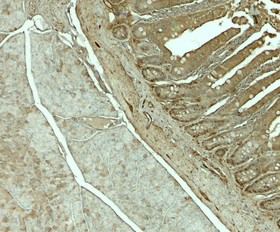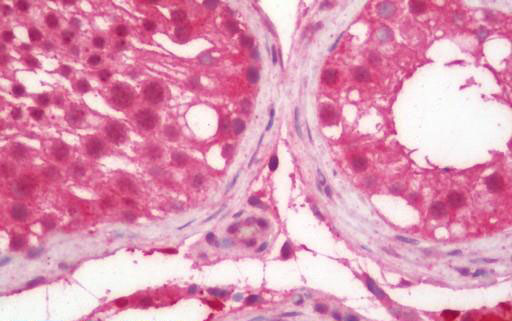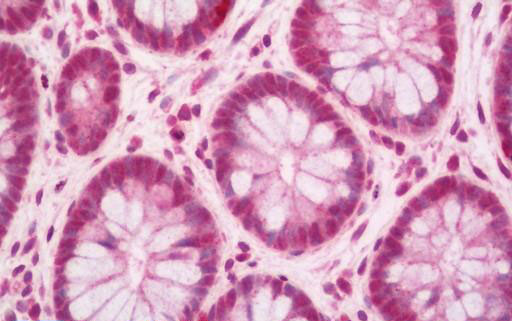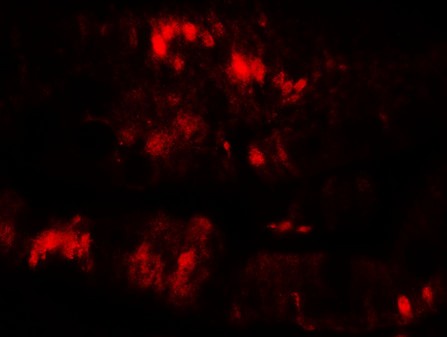SLC29A3 / ENT3 Antibody (N-Terminus)
Rabbit Polyclonal Antibody
- SPECIFICATION
- CITATIONS
- PROTOCOLS
- BACKGROUND

Application
| WB, IHC-P, IF, E |
|---|---|
| Primary Accession | Q9BZD2 |
| Other Accession | 55315 |
| Reactivity | Human, Mouse, Rat |
| Host | Rabbit |
| Clonality | Polyclonal |
| Calculated MW | 51815 Da |
| Dilution | IHC-P (10 µg/ml), WB (1 - 2 µg/ml), WB (1 - 2 µg/ml), |
| Gene ID | 55315 |
|---|---|
| Other Names | SLC29A3, ENT3, HCLAP, HJCD, HENT3, PHID |
| Target/Specificity | SLC29A3 antibody is human, mouse and rat reactive. At least two isoforms of SLC29A3 are known to exist; this antibody will detect both isoforms. SLC29A3 antibody is predicted to not cross-react with other SLC29 proteins. |
| Reconstitution & Storage | PBS, 0.02% sodium azide. Long term: -20°C; Short term: +4°C. Avoid repeat freeze-thaw cycles. |
| Precautions | SLC29A3 / ENT3 Antibody (N-Terminus) is for research use only and not for use in diagnostic or therapeutic procedures. |
| Name | SLC29A3 (HGNC:23096) |
|---|---|
| Synonyms | ENT3 |
| Function | Uniporter that mediates the facilitative transport of nucleoside across lysosomal and mitochondrial membranes (PubMed:15701636, PubMed:19164483, PubMed:20595384, PubMed:28729424). Functions as a non-electrogenic Na(+)-independent transporter (PubMed:15701636, PubMed:19164483, PubMed:28729424). Substrate transport is pH-dependent and enhanced under acidic condition, probably reflecting the location of the transporter in acidic intracellular compartments (PubMed:15701636, PubMed:19164483, PubMed:28729424). Proton is not a cotransporting ion but most likely change the ionization state of the transporter which dictates transport- permissible/impermissible conformation for nucleoside translocation (PubMed:28729424). May direct the nucleoside transport from lysosomes to cytosol or cytosol to mitochondria to facilitate the fundamental function of salvage synthesis of nucleic acids (PubMed:28729424). Involved in the transport of nucleosides (adenosine, guanosine, uridine, thymidine, cytidine and inosine) and deoxynucleosides (deoxyadenosine, deoxycytidine) (PubMed:15701636, PubMed:19164483, PubMed:20595384, PubMed:28729424). Also mediates transport of purine nucleobases (adenine, guanine) and pyrimidine nucleobases (uracil) (PubMed:15701636, PubMed:19164483). Also able to transport monoamine neurotransmitters dopamine, serotonin, noradrenaline and tyramine (PubMed:19164483). Capable of transporting ATP (PubMed:19164483). Mediates nucleoside export from lysosomes in macrophages, which regulates macrophage functions and numbers (By similarity). |
| Cellular Location | Lysosome membrane; Multi-pass membrane protein. Late endosome membrane; Multi-pass membrane protein. Mitochondrion membrane; Multi-pass membrane protein. Cell membrane; Multi-pass membrane protein. Note=Observed in a punctate intracellular pattern showing partial colocalization with late endosomes/lysosomes (PubMed:15701636). Detected at the cell surface only in certain placental cells (PubMed:19164483) |
| Tissue Location | Widely expressed in both adult and fetal tissues (PubMed:15701636). Highest levels in placenta, uterus, ovary, spleen, lymph node and bone marrow (PubMed:15701636). Expressed in liver (PubMed:19164483). Lowest levels in brain and heart (PubMed:15701636) Expressed in macrophages (PubMed:22174130) |

Thousands of laboratories across the world have published research that depended on the performance of antibodies from Abcepta to advance their research. Check out links to articles that cite our products in major peer-reviewed journals, organized by research category.
info@abcepta.com, and receive a free "I Love Antibodies" mug.
Provided below are standard protocols that you may find useful for product applications.
Background
Mediates both influx and efflux of nucleosides across the membrane (equilibrative transporter). Mediates transport of adenine, adenosine and uridine, as well as several nucleoside analog drugs, such as anticancer and antiviral agents, including cladribine, cordycepin, tubercidin and AZT. Does not transport hypoxanthine.
References
Hyde R.J.,et al.Mol. Membr. Biol. 18:53-63(2001).
Sankar N.,et al.Nucleic Acids Res. 30:4339-4350(2002).
Tse C.-M.,et al.Submitted (APR-2003) to the EMBL/GenBank/DDBJ databases.
Clark H.F.,et al.Genome Res. 13:2265-2270(2003).
Ota T.,et al.Nat. Genet. 36:40-45(2004).
If you have used an Abcepta product and would like to share how it has performed, please click on the "Submit Review" button and provide the requested information. Our staff will examine and post your review and contact you if needed.
If you have any additional inquiries please email technical services at tech@abcepta.com.













 Foundational characteristics of cancer include proliferation, angiogenesis, migration, evasion of apoptosis, and cellular immortality. Find key markers for these cellular processes and antibodies to detect them.
Foundational characteristics of cancer include proliferation, angiogenesis, migration, evasion of apoptosis, and cellular immortality. Find key markers for these cellular processes and antibodies to detect them. The SUMOplot™ Analysis Program predicts and scores sumoylation sites in your protein. SUMOylation is a post-translational modification involved in various cellular processes, such as nuclear-cytosolic transport, transcriptional regulation, apoptosis, protein stability, response to stress, and progression through the cell cycle.
The SUMOplot™ Analysis Program predicts and scores sumoylation sites in your protein. SUMOylation is a post-translational modification involved in various cellular processes, such as nuclear-cytosolic transport, transcriptional regulation, apoptosis, protein stability, response to stress, and progression through the cell cycle. The Autophagy Receptor Motif Plotter predicts and scores autophagy receptor binding sites in your protein. Identifying proteins connected to this pathway is critical to understanding the role of autophagy in physiological as well as pathological processes such as development, differentiation, neurodegenerative diseases, stress, infection, and cancer.
The Autophagy Receptor Motif Plotter predicts and scores autophagy receptor binding sites in your protein. Identifying proteins connected to this pathway is critical to understanding the role of autophagy in physiological as well as pathological processes such as development, differentiation, neurodegenerative diseases, stress, infection, and cancer.





